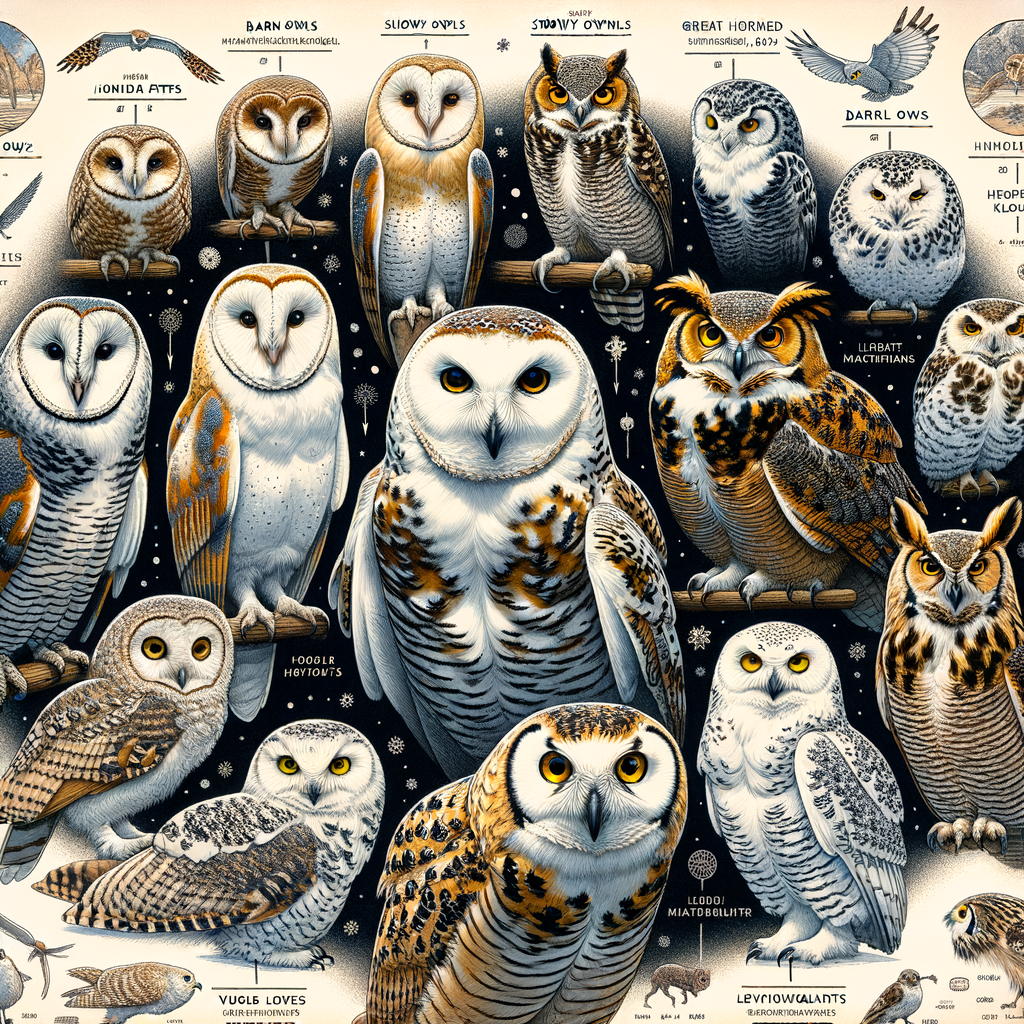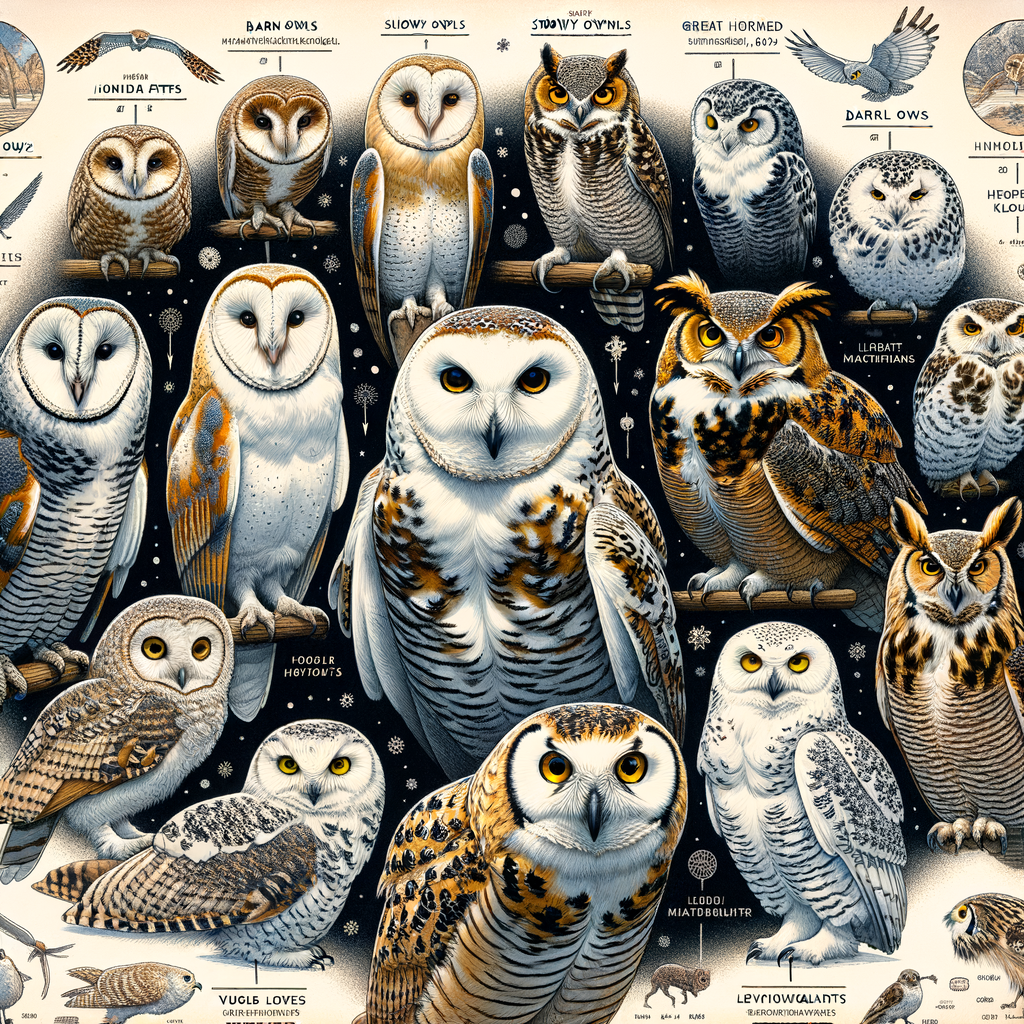
Introduction to Owl Lifespan
- Overview of the average lifespan of owls: Owls are fascinating birds with varying lifespans. On average, owls live between 10 to 15 years in the wild. Some species can live longer, especially in captivity where they face fewer threats.
- Factors affecting owl lifespan: Several factors influence how long an owl lives. These include their species, habitat, diet, and threats from predators or human activities. For instance, larger owl species tend to live longer than smaller ones.
- Importance of understanding owl lifespan: Knowing how long owls live helps scientists and conservationists protect these birds. It also helps us understand their role in the ecosystem. By studying owl lifespan, we can learn more about their health and how to keep their populations stable.
Owl Species Lifespan Comparison
Lifespan of Barn Owls
- Typical lifespan of barn owls in the wild: Barn owls usually live for about 4 to 5 years in the wild. However, some can live up to 10 years if they avoid predators and find enough food. The oldest recorded wild barn owl lived for 15 years.
- Longevity of barn owls in captivity: In captivity, barn owls can live much longer. They often reach 15 to 20 years because they have a steady food supply and are protected from predators. The longest-lived barn owl in captivity reached 34 years.
Lifespan of Snowy Owls
- Typical lifespan of snowy owls in the wild:
Snowy owls usually live for about 10 years in the wild. However, some can live up to 15 years. Their lifespan can be affected by factors like food availability and weather conditions. According to Wikipedia, snowy owls face threats from predators and human activities, which can shorten their lives. - Longevity of snowy owls in captivity:
In captivity, snowy owls can live much longer. They often reach up to 25 to 30 years. This is because they have a steady food supply and are protected from predators. For example, a snowy owl at a zoo can live a long and healthy life with proper care.
Lifespan of Great Horned Owls
- Typical lifespan of great horned owls in the wild:
Great horned owls usually live around 13 years in the wild. However, some have been known to live up to 28 years. These owls face many challenges like predators and food shortages, which can affect their lifespan. - Longevity of great horned owls in captivity:
They often reach ages of 20 to 30 years. The oldest recorded great horned owl lived to be 50 years old. In captivity, they have regular food and medical care, which helps them live longer.
Factors Affecting Owl Lifespan
-
Impact of Diet on Owl Lifespan
They mainly eat small mammals, birds, and insects. A diet rich in nutrients helps them stay strong and fight off diseases. For example, Barn Owls that have access to plenty of food can live up to 15 years in the wild. However, if food is scarce, their lifespan can be much shorter.
-
Effect of Habitat on Owl Lifespan
Owls need safe habitats with enough food and shelter. Forests, grasslands, and deserts can all be good homes for owls, depending on the species.
Owls living in protected areas, like national parks, often live longer because they face fewer threats from humans and predators.
-
Role of Predators in Owl Life Expectancy
Larger birds of prey, like eagles, and some mammals, such as foxes, can hunt owls. Young owls are especially vulnerable to these predators.
Adult owls have fewer natural enemies, but they still need to be cautious. Staying hidden and choosing safe nesting sites can help them avoid predators.
-
Impact of Diseases on Owl Lifespan
Common illnesses include avian flu and West Nile virus. These diseases can spread quickly and be deadly.
Healthy owls with strong immune systems are better at fighting off diseases. Regular access to clean water and food also helps keep them healthy.
Case Studies: Owl Lifespan in Different Environments
Case Study 1: Barn Owls in Urban vs. Rural Areas
- Comparison of Lifespan: Barn owls living in urban areas tend to have shorter lifespans compared to those in rural areas. On average, urban barn owls live around 3-4 years, while rural barn owls can live up to 5-6 years.
-
Key Factors Influencing Lifespan:
- Food Availability: In rural areas, barn owls have access to more natural prey like mice and voles. In urban areas, food sources can be scarce or contaminated.
- Predation and Human Activity: Urban barn owls face more threats from cars, buildings, and pollution. Rural barn owls are less exposed to these dangers.
- Nesting Sites: Rural areas offer more natural nesting sites like barns and trees. Urban areas may lack safe nesting spots, affecting the owls’ ability to reproduce and thrive.
Case Study 2: Snowy Owls in Arctic vs. Temperate Regions
- Comparison of lifespan
- Key factors influencing lifespan
Snowy Owls are fascinating creatures that live in both Arctic and temperate regions. Their lifespan can vary greatly depending on their environment.
Comparison of Lifespan
In the Arctic, Snowy Owls typically live up to 10 years. In temperate regions, their lifespan can be shorter, averaging around 7 years. This difference is due to various factors that affect their survival and health.
Key Factors Influencing Lifespan
- Food Availability: In the Arctic, Snowy Owls have a steady supply of lemmings, which are their main food source. In temperate regions, food can be harder to find, especially in winter.
- Climate: The harsh Arctic climate can be both a challenge and a benefit. While it is cold, there are fewer predators. In temperate regions, Snowy Owls face more competition and threats from other animals.
- Human Activity: In temperate areas, human activities like farming and urban development can disrupt the owls’ habitat. This can lead to a shorter lifespan due to loss of habitat and food sources.
| Region | Average Lifespan | Key Factors |
|---|---|---|
| Arctic | 10 years | Abundant food, fewer predators |
| Temperate | 7 years | Scarce food, more predators, human activity |
Understanding these factors helps us appreciate the challenges Snowy Owls face in different environments. By studying their lifespans, we can learn more about how to protect these majestic birds.
Conclusion: Understanding Owl Lifespan
-
- Summary of key findings
In this blog post, we explored the lifespan of owls. We learned that different species of owls have varying lifespans. For example, the Barn Owl lives around 4 years in the wild, while the Great Horned Owl can live up to 13 years. Factors like habitat, diet, and human impact play a big role in how long owls live.
-
- Importance of conservation efforts for owl longevity
Conservation efforts are crucial for the longevity of owls. Protecting their habitats from deforestation and pollution helps them live longer. Also, reducing the use of pesticides can save their food sources. By supporting conservation programs, we can ensure that owls continue to thrive for many years.






